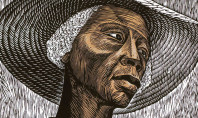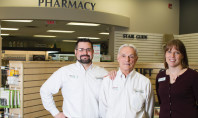Equi-librium A horse, of course, and more

A really cool therapy center occupies 18 lush acres of farmland along Fehr Rd. in Nazareth. Stop in sometime, and you’ll see people of all ages – who’ve been affected by physical, mental or behavioral disabilities – striving to maximize their quality-of-life.
It’s called Equi-librium, and (in various incarnations) it’s been an important part of the Lehigh Valley therapy scene for over 30 years.
Did I mention that some of the center’s most popular “therapists” have four legs, eat hay and oats and weigh about a half-ton?
Oh, yes. Equi-librium works its wonders with horses.
It’s actually an ancient concept, dating to the writings of Hippocrates. It was formalized in Europe about 50 years ago, and came to America in the late 1980s. The American Hippotherapy Association, formed in 1992, established practice standards, educational structures and assessment guidelines for clinicians in the field of Equine Assisted Therapy.
“He came home from the hospital in a wheelchair with a feeding tube, and we weren’t sure if he’d ever be able to do much by himself…” – Kim Wismer
The roots of Equi-librium took hold in 1982, when volunteers from the Monroe County 4H and the Monroe County Easter Seal Society formed “Monroe County Riding for the Handicapped” in Snydersville.
It was re-named Easter Seal RISE (Riding Instruction for Special Equestrians) after Easter Seals of Lehigh and Northampton Counties merged, and finally became Equi-librium, an independent 501(c) (3) non-profit organization in 2001.
Last year, Equi-librium relocated to its own farm in Nazareth. “Our goal from day one was to find a place in Northampton County,” says chairman and CEO Polly Beste. “We’re now closer to the people we serve, and have a much better facility.”
WHO USES IT?
Equi-librium draws on a diverse client base: riders range in age from 2 to 75, and display a spectrum of cognitive, physical, behavioral, psychological or sensory disabilities, including autism, developmental delay, multiple sclerosis, spinal cord injuries, and Down syndrome.
Typically, its participants enter via other rehab/vocational training centers, social service agencies, special-ed classes, as well as physician, therapist and personal referrals.
A HORSE, OF COURSE…AND MORE
Its therapy techniques are wide-ranging. “We also offer educational programs,” Beste says, “helping our clients learn about shapes by identifying them in our surroundings, for example. And they can use basic math to calculate the amount of food you’d give to a 2,000-pound horse versus a 250-pound miniature horse.”
Equi-librium also helps develop other motor skills, and a sense of responsibility; participants learn the complex multi-step process of saddling up, and can assist in grooming and feeding the animals.
“They also learn about cause-and-effect, and find that a farm isn’t the best setting for ‘acting out.’ Coming here motivates them to do better,” she adds. “We’ve had reports of up to 40% improvement in behaviors.”
HOW IT WORKS
A walking horse displays horizontal, vertical and lateral motion, all at once. “That does a lot of things to human muscles, especially in the core and legs, especially with children,” Beste says; riders unconsciously use those muscles as they try to stay upright.
“I’ve seen children who have very little muscle tone sit on a pad with a surcingle [strap that surrounds the horse’s girth]. Walkers lead the horse, and carefully watch the rider. By the second lap around the arena, the core muscles start to kick in, and the rider sits straighter,” she says.
AN AMAZING STORY
Kim Wismer of Nazareth has seen tremendous development in her son, Logan, as he went through the hippotherapy program.
Now 13, Logan suffered a brain injury at the age of 18 months during a near-drowning incident. “He came home from the hospital in a wheelchair with a feeding tube, and we weren’t sure if he’d ever be able to do much by himself,” Kim recalls.
The Wismers chose Equi-librium as an outpatient therapy when Logan turned four. Although he could only lie upon the horse at the beginning, today he’s enrolled in the developmental riding program, which entails less supervision.
It really is amazing. In kindergarten, Logan used a walker to get around. Now in sixth grade, he’s become so independent-minded that “he pushes you away if you try to help him!” Kim says.
“Equi-librium has been great for him,” she adds. “His legs and core muscles are stronger, and his balance has improved. And they’re accommodating to working parents – most other facilities make you cope with a strict 9-to-5 schedule.”
NOT JUST FOR KIDS
Disabled adults can reap rewards, as well. Doris Sterenchock, who’s had multiple sclerosis for about 20 years, turned to Equi-librium to improve her core strength and balancing ability.
“At first, the horse’s walking motions were enough to throw me off-balance,” Sterenchock says. But persistence – and her human therapist’s exercise instructions – paid off. Today, she’s able to “post” – a rhythmic rising-and-sitting in time with the horse’s gait – and her stronger legs make it easier for her to negotiate curbs and other obstacles while walking.
She’s also developed some independent riding skills. “Last fall, my husband and I toured a Gettysburg battlefield – on horseback!” she exclaims. “We had a blast!”
HOW TO HELP
Client fees cover only part of Equi-librium’s costs; other capital comes from fund-raisers, grants and corporate donations. But personal donations of cash and materials are always needed and, because each rider needs up to three assistants, volunteer hours are welcome, too. Just visit equi-librium.org, and click on the Volunteer or You Can Help button for more details.















